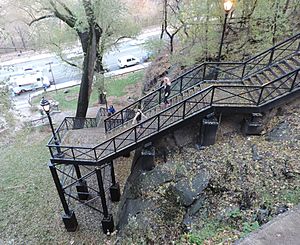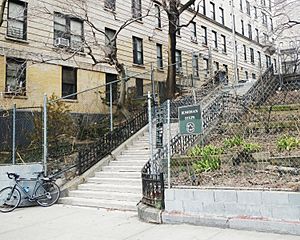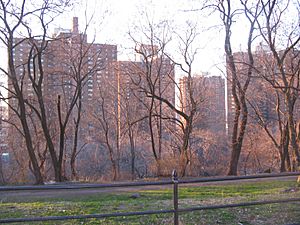Coogan's Bluff facts for kids
Coogan's Bluff is a tall, natural cliff in New York City. It's located in the Washington Heights area of Manhattan, right next to the Harlem River. This cliff stretches from 155th Street to 160th Street, between Edgecombe Avenue and the river. It drops about 175 feet down to the river, forming a sheltered area called Coogan's Hollow. For many years, a famous sports stadium called the Polo Grounds was located in Coogan's Hollow.
Contents
Who is Coogan's Bluff Named After?
Coogan's Bluff is named after James J. Coogan (1845–1915). He was a real estate developer and also served as the president of Manhattan for one term. He owned this land in the late 1800s and early 1900s. The name "Coogan's Bluff" first appeared in The New York Times newspaper in 1893.
The Famous Polo Grounds Stadium

The John T. Brush Stairway goes down through Highbridge Park to Harlem River Drive.
|
From 1890 to 1963, Coogan's Bluff looked down over the Polo Grounds. This was a professional sports stadium. It was the home field for the New York Giants baseball team from 1891 until 1957. Sportswriters often called the Polo Grounds "Coogan's Bluff." This is like how Chavez Ravine is used to talk about Dodger Stadium today. Even though the stadium was called the Polo Grounds, it was actually in Coogan's Hollow, the flat area below the bluff.
Two important stairways helped fans get to the stadium. The Bushman Steps led from the 155th Street subway station to the ticket booths. The John T. Brush Stairway then took fans down to the stadium. These two stairways are the only parts left from the Polo Grounds era. The Brush Stairway was named after the owner of the Giants team, John T. Brush.
Polo Grounds Towers: A Modern Community

Today, Coogan's Hollow is home to the Polo Grounds Towers. This is a large housing complex. It has four buildings, each 30 stories tall. Together, they have 1,616 apartments. The complex was finished in 1968. It is managed by the New York City Housing Authority.
There is also a Polo Grounds Community Center here. It offers programs for young people, like the Polo Grounds Youth Conference. A special plaque on the property shows where home plate used to be in the old stadium.
How to Get to Coogan's Bluff
You can reach Coogan's Bluff by taking the New York City Subway. Get off at the 155th Street station on the IND Concourse Line (B and D train). City buses also serve the area, including routes Bx6, Bx6 SBS, M2, M10.
Interesting Places Nearby
The Morris–Jumel Mansion, built in 1765, is very close by. It is the oldest house still standing in Manhattan and is now a museum. South of 155th Street, Coogan's Bluff becomes a smaller cliff inside Jackie Robinson Park.
Right across the Harlem River, in The Bronx, you can see Yankee Stadium. This is the home of the New York Yankees baseball team.




